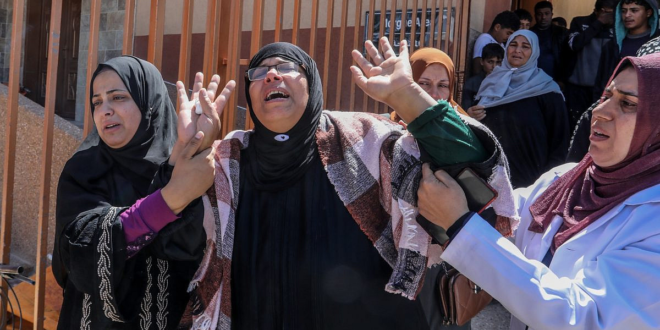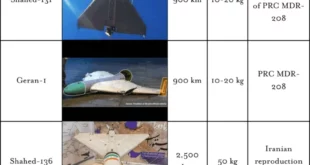Israel’s army is pummeling Gaza with an intensity that parallels the deadliest phase of the war, displacing civilians en masse from Rafah and Gaza City.
Since Israel shattered the ceasefire in Gaza last month, Palestinians have been facing horrors reminiscent of the first days of Israel’s genocidal onslaught. According to Gaza’s Health Ministry, the Israeli military has killed over 1,300 people and wounded more than 3,000 in the past three weeks, in which time the overall death toll in the enclave has surpassed 50,000.
Over 280,000 people have been displaced as Israel corrals Gaza’s population into ever-shrinking “humanitarian zones” which it continues to bomb. Nearly two-thirds of the entire territory of the Strip is now either under active displacement orders or defined by the military as a “no-go” area, with the army’s current operations focusing in particular on Gaza City in the north and Rafah in the south.
Israel’s total blockade on humanitarian aid has entered its sixth week, with starvation and malnutrition threatening to engulf Gaza’s whole population. And while Israeli forces continue to level entire residential blocks with bulldozers and explosive robots, they are executing journalists and medics in cold blood.
Schools-turned-shelters have also come under intense attack in recent days. On April 3, Israel bombed Dar Al-Arkam School in the Tuffah neighborhood in northeastern Gaza City, killing at least 31 people and wounding another 70. According to a spokesperson for Gaza’s Civil Defense, six people are still missing following the strikes, including a woman who was nine-months pregnant with twins.
Minutes later, Israel bombed another school in the same neighborhood, Fahd Al-Sabah, killing three people. More than half of the casualties in both strikes were children. (In response to +972’s inquiry, an Israeli army spokesperson claimed that Hamas used the schools as a “command and control center” — an allegation it makes regularly without providing evidence.)
Nasser Al-Shorfa lives around 100 meters from Dar Al-Arkam School, and the blast knocked him off his feet. “The ground shook beneath me,” the 55-year-old told +972, recalling the “deafening sound” of the explosion. “All the glass in our house shattered, and the doors were broken. My wife thought I was dead. We are still terrified from the bombing.”
Last week, the Israeli army issued evacuation orders encompassing much of Gaza City, including the neighborhood of Shuja’iyya, home to 25-year-old Sameh Said. At 1:30 a.m. on April 3, Said was woken up after being thrown across the room by the force of Israel’s bombardment of the area.
“I couldn’t tell if I was alive or dead until my brother splashed water on my face to remove the dust,” he told +972. “The entire wall of our house was smashed. The Israeli army bombed eight times within a few minutes.”
Said and his relatives tried to call ambulances to help their neighbors who were trapped under the rubble, but none reached the area until 6:00 a.m. During that time, Said said, a booby-trapped robot exploded in the neighborhood, while quadcopter drones opened fire at anyone seen moving.
According to Emily Tripp, the director of the aerial warfare monitoring group Airwars, the intensity of Israel’s attacks since it resumed its bombardment “only really compares to the first weeks of October 2023” — a period in which Airwars documented “almost unparalleled rates of civilian harm.”
While the organization is continuing to fully assess the scale of Israel’s latest attacks, Tripp added: “Our early research already shows that the first wave of strikes after the ceasefire were more frequent, widespread, and likely killed more civilians than even some of the deadliest days of the war to date.”
‘Every night we see hell’
In Gaza’s southernmost city of Rafah, a surge of Israeli airstrikes accompanied an announcement last week that the army had “encircled” the city to create a new military axis — the “Morag Corridor” — named after a Jewish settlement that once stood between Rafah and Khan Younis. The 12-kilometer stretch of land that bisects the Strip from east to west includes large portions of agricultural land as well as areas that Israel had previously designated as a “humanitarian zone” for displaced Palestinian to seek shelter.
According to Gaza’s Government Media Office, the army has destroyed more than 90 percent of Rafah’s residential neighborhoods — more than 50,000 housing units — over the course of the war, and rendered 22 of the city’s 24 water wells non-functional. Over 85 percent of the city’s sewage network has also been destroyed, and 320 kilometers of streets have been bulldozed.
“The vast majority of Rafah’s residents have been forced to leave under the threat of bombing,” Ismail Al-Thuwabtah, a resident of the city, told +972. “The violent shelling and lack of security have rendered the city a disaster zone, devoid of basic services.”
Still, some families in Rafah are refusing to evacuate, citing the lack of assurances that they will be safer in Al-Mawasi, where the Israeli army is ordering them to flee. “I couldn’t bear the repeated evacuations, so I decided to stay here,” 40-year-old Rami Ghossein, from the neighborhood of Khirbet Al-Adas, explained. “There are eight people in the house, including some who are elderly and sick. Where would we take them?
“Every night we see hell because of the non-stop bombing,” he continued. “Different types of shells and heavy missiles shake the entire region. Apaches and F-16s fire at homes. Israel has no red lines. They don’t care about civilians. I want to die in my home; I don’t want to leave and return to see it destroyed or occupied.”
“We are losing Rafah to this hideous ground operation,” 28-year-old Ahmed Kassab, from the Tel Al-Sultan neighborhood, lamented after fleeing to Al-Mawasi. “We are living in tragic conditions in tents with a lack of water and food, and the sound of bombing doesn’t stop for a moment. Our lives are in danger. We’re asking the world to keep their eyes on Rafah and save it.”
In Khan Younis, too, Israel continues to attack residential homes. On April 4, the army bombed the Al-Aqqad family’s three-story house in the Al-Manara neighborhood, killing 25 people. Khaled Al-Aqqad, 30, was in a neighboring house when his relatives’ home was hit with no advance warning.
“At midnight we woke up to the sound of a huge missile exploding, which shook the entire area,” he told +972. “We ran out, looking for our children, and shouting, ‘Is anyone alive?’”
Al-Aqqad said it was difficult for medics to save those trapped under the rubble. Around 15 survivors were eventually transported to the European Hospital for treatment.
“We are civilians in our homes,” Al-Aqqad pleaded. “We don’t want to be displaced to unsafe areas. The army targets everyone without exception. We want the world to act and save us, otherwise they’ll kill us all.”
 Eurasia Press & News
Eurasia Press & News



